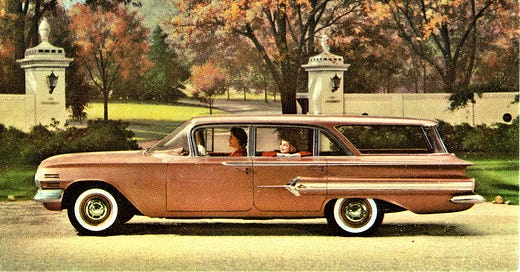Station Wagons and Affluence
A fascinating, insightful letter from a reader and station wagon driver
Today’s post is a letter from a reader responding to my recent piece at The Week on station wagons—specifically, suggesting that the station wagon should be made in large numbers again, and nudge larger, more dangerous cars off the road. After all, it’s just about as roomy as an SUV or minivan, but it provides better driver visibility, is less dangerous in a pedestrian crash, and can’t easily roll over.
Dan Moore, who wrote this up, is also a station wagon fan, but he suggests here that there are some drawbacks to its general design, little details that modern, more affluent Americans would have trouble accepting in everyday life.
I’ve been driving a 1992 Buick Roadmaster for about five years now, and I curse the light-truck loopholes every time I get into it, so I really enjoyed your station wagon piece. But driving my Roadmaster every day has made me acutely aware of some of the limitations of wagons as family cars (and, more broadly, of old things I’m sympathetic to vs. new ones I’m inclined to dislike).
The interesting thing about driving a car from 30 years ago built to plans from 50 years ago is that you’re inhabiting the very different assumptions made by a culture very similar to yours. I’m 34; my first car was a little 2000 Mercury Mystique. Modern cars teach you to be a little high-strung, to ride the gas and the brakes. A full-size American car, built to Silent Generation spec, just keeps going when you point it down the street. It won’t go quickly—it won’t do anything quickly—but it doesn’t ask for or benefit from constant input. It floats over the road and you float over it, on soft and uncontoured bench seats. Sometimes I feel like I’m using alien technology, or at least that Roman concrete for which we lost the recipe; it’s just an entirely separate, very pleasant way to conceive of driving.
The nice thing about driving it is everyone wants to talk about it—a couple of weeks ago a neighbor stopped to tell my wife that her kindergartener son says “there’s the F-16 car” every time they walk by our house on the corner. (These Roadmasters first appealed to me as a weird mix of postwar nostalgia and high ’80s-tube-car modernism.)
The bad thing about driving it is that you’re constantly reminded that you’re richer than the people who bought your car, in ways that have changed what you value. Families have grown accustomed to more space, less crouching, big car seats, more safety features…. Taken all together, the changes from wagon-world to crossover-world have made the built environment harder and less appealing to live in, but driving my wagon was the first thing to make me realize how important and difficult it will be to distinguish changes born of regulatory loopholes and brief locked-in fads from the durable improvements we’ve reaped from being richer and having faster computers.
For family cars, it’s made me separate the giant SUV maws and pillbox greenhouses from the realization that it actually is harder to lower your 30-pound daughter into her carseat in your wagon than it is to shift them into a minivan at chest level, and less convenient and safe to shunt your older kid into the wayback than it is to let them walk back into the third row themselves. (Sliding doors are great, too—I’d put a sliding door on everything if I got my way.) My wagon feels smaller inside than a minivan, but it barely fits into a normal garage; three of its eight seats, the two wayback jump seats and the front-middle spot on the bench, are places American adults mostly don’t want to sit anymore, almost in the same way they don’t want to ride on the handlebars of a bike.
I’ve felt some of the same things living in our mid-century ranch house after growing up in new construction. Living next-door to a park, or a mile’s walk from my job in the middle of Tucson, is self-evidently great, and it’s easy to convince someone to give up some yard—especially our pointless rock yards here in Arizona—for that kind of convenience. But my relatives wouldn’t want to deal with our house’s tiny bedrooms, and forget about putting two kids in each one like its first owner probably did. Our kitchen is small, our bathrooms are tiny; some of the houses on our street have a garage or a carport, but ours doesn’t. (In the Arizona sun, this has done horrible things to my woodgrain.)
This isn’t really a novel thought, but hugely visible inequality and the degree to which we’ve traded off, say, one elegant flight every two years with full meal service against three general-admission bus rides on Frontier make it hard to notice how much more materially wealthy a lot of us are. It’s difficult to see our parents and grandparents eating out a third as often as we do, or wearing the same clothes for years, and easy to see that their restaurants seem nicer and they’re all wearing suits.
Because they’re so durable, cars and houses really force those trades into the light; I hope that writing like yours helps people disaggregate the things about modern life they wouldn’t miss from the things they will find it unexpectedly difficult to give up. (More selfishly, I also hope it nudges an automaker toward bringing back its 18-foot-long station wagons.)
Follow Dan Moore on Twitter: @danup. Photo credit Alden Jewell/Flickr, CC BY 2.0
Related Reading:



